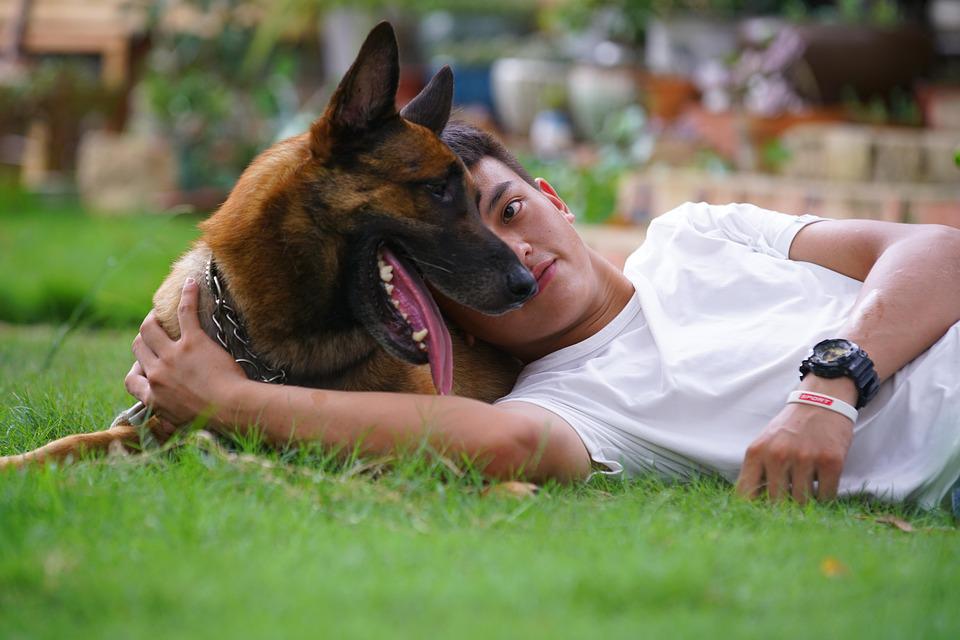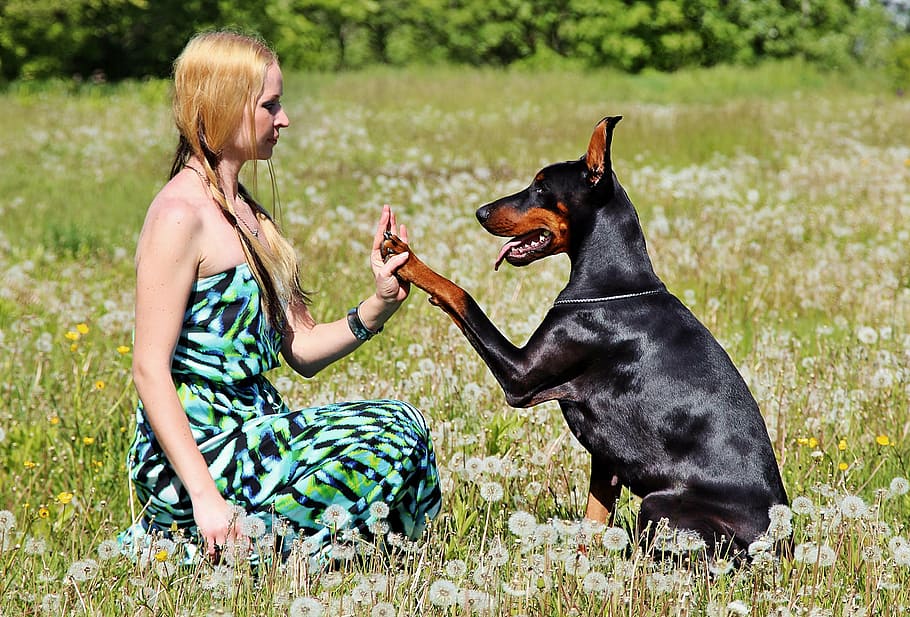What Are Social Behaviors in Dogs?
The friendly character of the dog is a point often put forward. Indeed, thanks to its excellent socialization and innate learning capacity (double imprint), this domestic animal can maintain excellent relations with the man.
The dog’s sociable character: definitions
The social animal
When its members are structured into enduring groups of individuals and share similar communication norms, we say we’re in the presence of a social species.
Share tasks (collaboration).
This organization can take many different forms, specific to each species. There is nothing comparable, for example, between an ant and a wolf or a lion and a hyena.
It’s important to remember that dogs and humans are not of the same species and do not share the same communication codes.
The concept of behavior
Behavior is defined as all the actions and reactions of an individual in a given situation:
It can vary considerably depending on each individual, their experience, the environment, the people in the relationship, and their emotional and physiological state at the time.
It might be innate or learned, conscious or unconscious, intentional or involuntary, automatic or regulated.
However, for a social group to originate, thrive, and develop, universally understood and approved social practices are required.
What social behaviors do dogs exhibit?
Social behaviors, in general, are the codification of specific behaviors to improve group communication, exchanges, cohesion, and survival (reproduction, hunting, education, and defense of young). They can be based on tight hierarchies (hyenas), caste hierarchies (ants), friendly relationships (bonobos), and so on. Above and beyond the rituals, they are distinct.
Rituals
Rituals are supposed to lessen or eliminate ambiguity and stress in a relationship. They’re also an excellent way to settle a disagreement. They are often presented as dominance/submission signals – essentially question/response (communication) signals which are often presented as dominance/submission signals. In wolves:
The elders’ pacifying and instructional role towards the younger ones is the basis of rituals, not hierarchical subjugation.
Some scientists believe that the wolf society would be the most sophisticated after the human community, owing to the frequent observation of selfless acts (for the benefit of others and not oneself).
As a result, many submissive behaviors are, above all, appeasing behaviors that allow confrontations to be avoided; one puts an end to its threatening attitude based on criteria that are relatively unknown to us but generally seen.
Appeasement
Appeasement does not imply that one animal submits to another. It’s a complicated form of communication that’s little known yet highly effective:
This behavior is usually reciprocal, meaning that the subject who “gives in” first causes appeasement behavior in his opponent. It is this reciprocity that allows the conflict to end.
In return, all conflictual or submissive behavior should be concluded by appeasing behavior, especially on our part.
One could say that this type of behavior is, above all, a mark of reciprocal respect. It is a sign of a highly evolved and peaceful social organization, which is undoubtedly the case with the wolf (within a pact, of course).
This social behavior allows wolves to never resort to brute force and even less to the bite that would decimate the pact. Wounds are almost non-existent in the pact because the first thing taught is biting inhibition.
Biting inhibition
Since the wolf has a particularly formidable jaw, bites, if not perfectly controlled, would be lethal almost every time. Through rituals and appeasement, conflicts are resolved peacefully, one might say. The mere presence of the Alpha wolf (leader), even if there is no danger from him, is frequently enough to soothe the agitated ones who indicate it by adopting polite postures. It is a lifelong learning process that permits the cub to adopt the pact’s codes to promote cohesion and survival: socialization.
Socialization of the dog: the importance of socialization

Early socialization
Socialization begins early in the dog’s existence, possibly as early as gestation, and displays itself in the fetus’s biochemical and auditory cues.
After whelping, behavioral socialization begins in:
- cub, as early as the first week while it is still blind and deaf;
- puppy, from the fourth week.
Even though the learning process takes several months, socialization takes place over the next four weeks. According to biologist Kathryn Lord’s study, A Comparison of the Sensory Development of Wolves and Dogs, it would only take 90 minutes to create a stable and durable social bond between the dog and man, or even other animals and things, during this period (between 4 and 8 weeks) (car, bicycle, vacuum cleaner, etc.)
Socialization with fellow dogs
It is necessary to encourage as often as possible, at least until adulthood, to achieve a maximum and reliable socialization of the dog towards its fellow dogs:
- free contact between them;
- mixing of young and adult dogs
- no human intervention;
- the variety, as much as possible, of partners.
Indeed, there can be no better educators for dogs than other dogs and bitches. To want to intervene too early, especially between dogs, before the social development is fully accomplished, will be more of a source of de-socialization than of socialization. Thus, this socialization between members of a species will considerably influence the general relationship between dogs and the relationship with a man.
Socialization to humans
A dog’s level of socialization with a man is frequently determined by its level of obedience or even submission to him. Unfortunately, this error of judgment can have quite unfortunate consequences. Indeed, would one say that a friendly person is submissive and obedient? However, it has not escaped anyone’s attention that the dog is a great communicator. He knows how to make himself understood, or at least tries to. But do we know him? And do we try to make ourselves understood by him so he can understand? However, what distinguishes him from any other animal is a unique, unequaled, innate characteristic: the double imprint. This extraordinary faculty allows him to make sense of our behavior and learn how to behave.
The phenomenon of double imprinting in dogs
The double imprint is a natural propensity to behave one way with his fellow dogs and another with people, stemming directly from domestication and socialization. Therefore, the dog must be able to acquire the codes of both species naturally. This explains the importance of letting him learn the canine principles without human intervention to develop his social sense. He will then be able to quickly transpose his relationships with humans (bite inhibition, conflict avoidance, etc.). It is mainly through observation that the dog will be able to do 2 things:
- To give meaning to our emotions, observing our emotional reactions will then be essential for the dog to know how to behave in a similar situation. If we are calm in one case, the dog will be too. If we feel fear in another, the dog will think that it must feel it.
- Ritualize the main relationships: this is the best way for him to know whether something will happen or not. The dog is very good at locating our signals and behaviors that may benefit him. There is no need to teach him; he finds it by himself and at an incredible speed, but not always how we expect or hope. Therefore, ritualizing everyday behaviors is an excellent way to establish reliable and effective communication, more than any conditioning.
When and how to socialize your dog?
Since socialization is essential for dogs and since they have a strong mimetic capacity (double imprinting), it is evident that a dog’s friendly character develops at several stages of its life.
Pre-adoption
As far as socialization is concerned, starting at the fourth week, the breeder has a great responsibility towards the puppy, without being able to say if the family breeding has more virtues than the professional breeding. It is about the same. There are 2 types of factors that help socialization:
Of course, the sounds, the smells, the movements, and the presence of other animal species will accustom the puppy to the human environment.
But, what will permit his adaptation will be the signals his mother will transmit to him because she and her alone ” judge” what is suitable or not for her puppies.
Handling the puppies believing they are used to us is a mistake frequently made. Indeed, if the mother is worried about this attitude (even if she is not present at the time), she will communicate it to her puppies, who may develop mistrust towards the human. Thus, the human behavior with the bitch and the puppies is essential:
On the other hand, everything “positive” that the bitch transmits to them will be integrated for life in the puppy:
If she allows them to go toward humans and others without restriction, the game is won. The relationship with the bitch is the key to the puppy’s socialization.
But nothing is lost if this is not the case. It will just be a shame to have missed this unique and natural opportunity.
After two months
The most important thing will be to continue the development of the social sense, specifically canine, by allowing the young dog the maximum of interactions with:
- other dogs (socialized);
- humans by dissociating them well (no intervention between the dogs).
The best solution will allow the puppy to observe our behaviors and react to them naturally. It will then be enough, generally, to:
encourage the desired behaviors;
- Pay no attention to undesirable behaviors.
- Please note that we are talking about socialization only. Establishing reliable and more elaborate communication will be another point to consider from an educational perspective.
In adulthood
A dog learns and is capable of learning from us all his life. As soon as a dog shows the desire to communicate and propose behaviors on his own, he shows his desire to integrate or signals difficulties in integration (misunderstandings, for example). And conditioning (obedience) will rarely be the most appropriate solution.

1 thought on “What Are Social Behaviors in Dogs?”